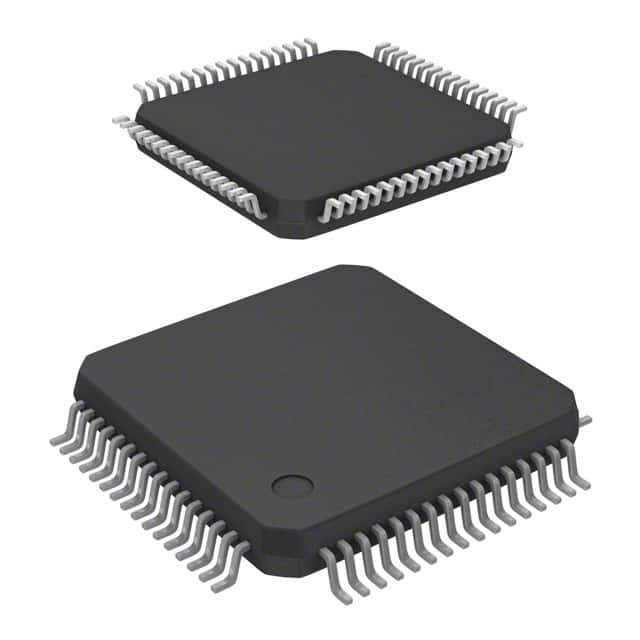Lihat spesifikasi untuk detail produk.

MC9S08AC48CPUE
Product Overview
- Category: Microcontroller
- Use: Embedded systems, consumer electronics, automotive applications
- Characteristics: Low power consumption, high performance, integrated peripherals
- Package: 48-pin LQFP (Low-profile Quad Flat Package)
- Essence: A microcontroller designed for various applications requiring low power and high performance.
- Packaging/Quantity: Available in tape and reel packaging, quantity depends on the supplier.
Specifications
- CPU: 8-bit S08 core
- Clock Speed: Up to 48 MHz
- Flash Memory: 48 KB
- RAM: 4 KB
- Operating Voltage: 2.7V to 5.5V
- I/O Pins: 38
- Timers: 6-channel TPM/PWM module
- Communication Interfaces: UART, SPI, I2C
- Analog-to-Digital Converter (ADC): 10-bit, 16 channels
- Temperature Range: -40°C to +85°C
Detailed Pin Configuration
The MC9S08AC48CPUE has a total of 48 pins. The pin configuration is as follows:
- VDD - Power supply voltage
- VSS - Ground
- PTA0 - General-purpose I/O pin
- PTA1 - General-purpose I/O pin
- PTA2 - General-purpose I/O pin
- PTA3 - General-purpose I/O pin
- PTA4 - General-purpose I/O pin
- PTA5 - General-purpose I/O pin
- PTA6 - General-purpose I/O pin
- PTA7 - General-purpose I/O pin
- RESET - Reset pin
- PTB0 - General-purpose I/O pin
- PTB1 - General-purpose I/O pin
- PTB2 - General-purpose I/O pin
- PTB3 - General-purpose I/O pin
- PTB4 - General-purpose I/O pin
- PTB5 - General-purpose I/O pin
- PTB6 - General-purpose I/O pin
- PTB7 - General-purpose I/O pin
- PTC0 - General-purpose I/O pin
- PTC1 - General-purpose I/O pin
- PTC2 - General-purpose I/O pin
- PTC3 - General-purpose I/O pin
- PTC4 - General-purpose I/O pin
- PTC5 - General-purpose I/O pin
- PTC6 - General-purpose I/O pin
- PTC7 - General-purpose I/O pin
- IRQ - Interrupt request pin
- RXD - UART receive pin
- TXD - UART transmit pin
- SDA - I2C data pin
- SCL - I2C clock pin
- SS - SPI slave select pin
- MOSI - SPI master out, slave in pin
- MISO - SPI master in, slave out pin
- SCK - SPI clock pin
- AD0 - Analog input channel 0
- AD1 - Analog input channel 1 39-48. Reserved
Functional Features
- Low power consumption: The MC9S08AC48CPUE is designed to operate efficiently with low power requirements, making it suitable for battery-powered applications.
- High performance: With a clock speed of up to 48 MHz and an 8-bit S08 core, this microcontroller offers fast and reliable processing capabilities.
- Integrated peripherals: The device includes various integrated peripherals such as UART, SPI, I2C, timers, and an ADC, providing flexibility for different application requirements.
Advantages and Disadvantages
Advantages: - Low power consumption enables energy-efficient designs. - High-performance processing capabilities allow for quick execution of tasks. - Integrated peripherals reduce the need for external components, saving space and cost.
Disadvantages: - Limited flash memory and RAM compared to higher-end microcontrollers. - 8-bit architecture may not be suitable for complex applications requiring extensive computational power.
Working Principles
The MC9S08AC48CPUE operates based on the principles of a microcontroller. It executes instructions stored in its flash memory, processes data, and interacts with external devices through its integrated peripherals. The CPU core performs arithmetic and logical operations, while the various I/O pins enable communication with other components or systems.
Detailed Application Field Plans
The MC9S08AC48CPUE is widely used in the following application fields:
- Embedded Systems: The microcontroller's low power consumption and integrated peripherals make it suitable for various embedded systems, including home automation, industrial control, and IoT devices.
- Consumer Electronics: Due to its high performance and compact package, the MC9S08AC
Sebutkan 10 pertanyaan dan jawaban umum terkait penerapan MC9S08AC48CPUE dalam solusi teknis
Sure! Here are 10 common questions and answers related to the application of MC9S08AC48CPUE in technical solutions:
Q: What is MC9S08AC48CPUE? A: MC9S08AC48CPUE is a microcontroller unit (MCU) manufactured by NXP Semiconductors, commonly used in embedded systems.
Q: What are the key features of MC9S08AC48CPUE? A: Some key features include an 8-bit CPU core, 48KB flash memory, 4KB RAM, multiple communication interfaces, and various peripherals.
Q: What applications can MC9S08AC48CPUE be used for? A: MC9S08AC48CPUE is suitable for a wide range of applications, including industrial control systems, consumer electronics, automotive systems, and home automation.
Q: How can I program MC9S08AC48CPUE? A: You can program MC9S08AC48CPUE using various development tools such as Integrated Development Environments (IDEs) like CodeWarrior or third-party compilers.
Q: What programming languages are supported by MC9S08AC48CPUE? A: MC9S08AC48CPUE supports assembly language and C programming. Some IDEs may also support other high-level languages.
Q: Can MC9S08AC48CPUE communicate with other devices? A: Yes, MC9S08AC48CPUE has built-in communication interfaces like UART, SPI, and I2C, which allow it to communicate with other devices or modules.
Q: How can I debug my code running on MC9S08AC48CPUE? A: MC9S08AC48CPUE supports various debugging methods, including in-circuit debugging using a debugger or emulator, or through serial communication.
Q: Can MC9S08AC48CPUE handle real-time tasks? A: Yes, MC9S08AC48CPUE has a real-time clock (RTC) module and can be programmed to handle real-time tasks with precise timing requirements.
Q: Is MC9S08AC48CPUE suitable for low-power applications? A: Yes, MC9S08AC48CPUE is designed to operate at low power and has power-saving features like multiple low-power modes and wake-up interrupts.
Q: Are there any development boards available for MC9S08AC48CPUE? A: Yes, NXP provides development boards specifically designed for MC9S08AC48CPUE, which include necessary peripherals and connectors for easy prototyping and testing.
Please note that the answers provided here are general and may vary depending on specific use cases and requirements.

